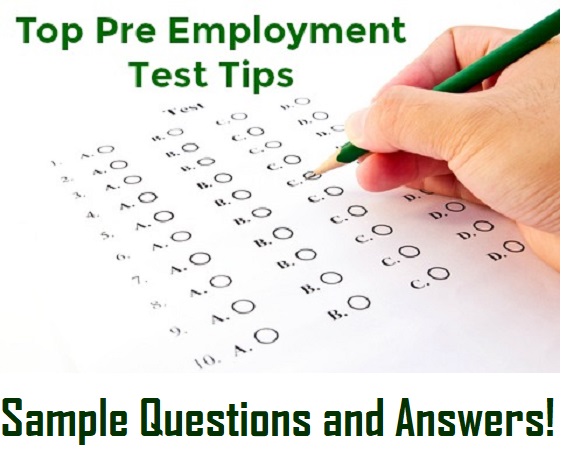Pre Employment Assessment Test Questions and Answers PDF - Aptitude Test Sample Questions and Answers
Pre Employment Assessment Test Questions and Answers PDF
What is Pre Employment Assessment Test?
- Diagraming Reasoning Test
- Situational Judgement Test
- Verbal Reasoning Test
- Abstract Reasoning Test
- Logical Reasoning Test
- Math Reasoning Test
- Numerical Reasoning Test
Aptitude Test Sample Questions and Answers PDF
Psychological Tests.
Knowledge Tests –
Skills Tests
Ability Tests
Tests of Other Characteristics
Aptitude Test Sample Questions and Answers 2021

The correct answer is (S T R A T E G I C)
Imagine a 4x6 shape with grey squares on the inside and white squares on the outside. It was broken into 2x2 shapes and 3 of the shapes shown belong to the larger shape and one doesn’t. Which one does not belong to the group?

A. 30, 35
B. 35, 40
C. 40, 65
D. 75, 95
The correct answer is C (40, 65)
A. 4,2,5,3,1
B. 5,2,4,3,1
C. 4,2,1,3,5
D. 4,2,5,1,3



The correct answer is (B)
A. Chart
B. Shape
C. Graph
D. Point

The correct answer is B (Shape)


The correct answer is (A)
A) 12
C) 16
B) 9
D) 13

The correct answer is C (16)
A. Shape
C. Number
B. Letter
D. Animal

The correct answer is B (Letter)
A. 13
C. 33
B. 23
D. 43
The correct answer is C (33)
A. 7, 8, 2
B. 9, 6, 7
C. 9, 8, 5
D. 7, 6, 1

The correct answer is C (9, 6, 7)
8 + 4 = 32
9 + 6 = 35
3 + 8 = 31
0 + 1 = ?
A. 1
B. 11
C. 21
D. 31
The correct answer is (C)
A. $ 40
B. $ 55
C. $ 38
D. $ 25
The correct answer is C ($ 38)
There are 3 senior math classes. First-class has 23 female students and 18 male students. The second class has 20 female students and 24 male students. The third class has 14 female students and 20 male students. What is the ratio of the female students to the total number of students in the second class?
A. 20:119
B. 4:11
C. 20:44
D. 20:62
The correct answer is B (4:11)
A. 10 cakes
B. 20 cakes
C. 30 cakes
D. 40 cakes
The correct answer is B (20 cakes)



















Comments
Post a Comment